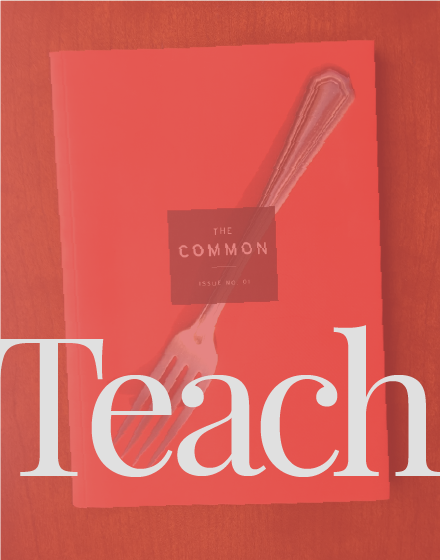Learn more about teaching The Common and request a free sample issue.
Group Assignment & Student-led Exercise: Divide students into small groups (trios work well) and give them a week to:
- Meet together outside of class with their copies of The Common in hand;
- Select, as a group, a poem they particularly like,
- Prepare to read that poem aloud to the class, and
- Design and lead an in-class writing exercise for their classmates and teacher that is inspired by a technique or aspect of that poem.
Example
One group chose Fatimah Asghar’s poem “Kul” from Issue 14, read the poem aloud, and noted that it was based on one word that could mean several, potentially opposite things – a contronym. The students had generated a list of contronyms in advance and projected them on the board (e.g., “sanction,” “oversight,” and “left”). They then invited their classmates to write at least a few lines of a poem that would, in their words, embrace these opposite meanings.
“I like this exercise not only because it gets students engaging with the fresh texts in detailed ways (at the same time we are all receiving and getting into our new issues) and working together, but also because it gives them a sense of what it is like to be in front of a class, teaching (potentially useful information for those who may be considering that path.)” – Amy Weldon
Adapted from Amy Weldon, Professor of English, Luther College
Assignment: Report on Issues 9 & 10 of The Common; select and discuss various, particular elements of the literary journal. 7 pages (2,100 words) minimum.
You will select and discuss 7 items, including “Fragments/Fragmentos” by Luis Munoz, page 182, Issue 9, and one from each of the categories below. You must write about at least one item from each issue. Choose from among:
—The Common Statement
—Fiction
—Essays
—Art
—Poetry
—Elsewhere (Bombay/Mumbai, New Poems from China.)
Discussion should lead to two results.
1. Analysis and clarification of the material. What is the author saying? What is the author’s intended effects of key words in the text? What do you see as the theme of this story, poem, or play? What elements contribute to this theme?
2. Response to, and criticism of, the author’s work. What do you think of the author’s techniques? Is the author’s argument about poetics well reasoned and convincing? How does this poem make you feel? Why? What connections (harmonies or conflicts) do you find between this author’s ideas and those of others we have studied?
Adapted from Judy Baumel, Professor of English and Founding Director of Creative Writing, Adelphi University
Learn more about teaching The Common and request a free sample issue.


